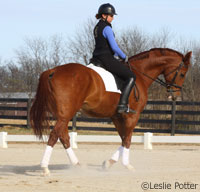 |
| Flatwork at the walk can help improve communication with your horse over fences. Photo: Leslie Potter |
Q: I recently bought an 8-year-old Arabian-cross gelding that has evented before, but I’m just starting. He often runs out or refuses a new fence, and once I get him over it, he will jump it the next time with a lot of room to spare. How can I teach him to be more consistent?
Even my Olympic horse, McKinlaigh, needed regular schooling on flatwork basics. To keep him listening to my aids, one exercise I used involved alternating turns on the forehand at the walk. Here’s how you can try it:
1) Using one end of an arena, ride a 20-meter-diameter square instead of a circle. Walk your horse along the square, focusing on connecting him from your inside leg to your outside rein while making him light on the inside rein.
2) Ride down the side of the square that follows the long side of the arena at the walk, staying about 1 meter off the rail.
3) As you approach the first corner of your square, bend your horse to the inside while using your inside leg to push his hindquarters over.
4) As your horse begins to move his hindquarters over, use your outside rein to “capture” his outside shoulder and ride a walking quarter-turn on the forehand. Maintain forward movement and ask your horse to take two or three exaggerated steps over with his hindquarters, focusing on engaging his inside hind leg and maintaining inside bend. After a quarter-turn, you should be facing the next side of the square.
5) Walk along the short side of the arena toward the next long side. Make sure you ride a straight line, and don’t let your horse continue sideways.
6) Repeat the turn in each corner until your horse is easily moving away from your inside leg, taking the contact on the outside rein. The inside rein should be very soft. Practice the entire exercise in both directions.
If your horse bulges his shoulder to the outside as you’re trying to bend him to the inside, improve your overall control of his shoulder by focusing on riding straight with the outside aids. If your horse wants to fall inward on the bend, ask for more energy from his hind end and maintain your connection with the reins, using an opening inside rein.
Try this exercise on an older, more experienced horse first, if possible, so you can get the idea of how it should feel. Many riders overlook the value of these schoolmasters. A trainer can try to explain the concept of feel, but the best way to learn is being guided by a horse that knows what he’s doing.
— Gina Miles
Ask your questions on the horseillustrated.com Forums >>
See more Expert Q&As >>
Submit your Ask the Expert question >>
Eventer Gina Miles won an individual silver medal aboard the Irish Sport Horse gelding McKinlaigh at the 2008 Olympic Games. In 2007, they won team gold and individual bronze representing the United States at the Pan American Games. Miles runs a full-service eventing facility at Rancho del Rio in Atascadero, Calif.
This article originally appeared in the January 2011 issue of Horse Illustrated. Click here to subscribe.






Thank you for the article
Good advice